DIONYSOS MYTHS 1
Greek Name
Διονυσος
Transliteration
Dionysos
Latin Spelling
Dionysus
Translation
Liber, Bacchus
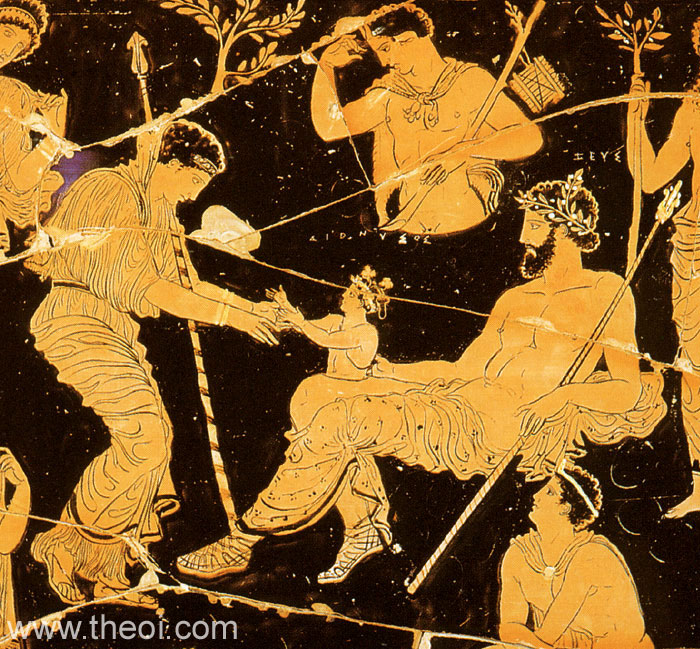
DIONYSOS was the Olympian god of wine, vegetation, pleasure, festivity, madness and frenzy.
This page contains stories of Dionysos from his youth including his birth, nursing and home on Mount Nysa.
The second "Myths" page continues with general stories of the god in Greece, while the third page describes his adventures in North Africa, Asia Minor and the East.
CLASSICAL LITERATURE QUOTES
BIRTH & NURSING OF DIONYSUS BACCHUS
Dionysos was born from the thigh of Zeus after his own mother Semele was consumed in the lightnings of Zeus. He was then entrusted to the care of certain nymphs on Mount Nysa.
The identity of these nurses and their mountain vary according to various accounts:--
1. The most common version identified Nysa with the Boiotian Mt Kithairon, located between Thebes and Eleusis. Here Dionysos was nursed by his three aunts--Ino, Agaue and Autonoe--who abandoned their own husbands and children to take care of the godling in the mountain wilds. They were sometimes called the Nymphai Nysiades (Nymphs of Nysa), who later came to be regarded as a seperate set of nurses. His mentor on the mountain was the elderly satyros Seilenos (also called Nysos, as the god of the mountain).
2. The Euboians also had their own tradition, saying Dionysos was reared in the mountains of their island. According to their tales his nurse was Makris, and his mentor, his uncle the demigod Aristaios (who may have been identified with Seilenos).
3. The Naxians claimed that Dionysos was raised on their island by the Hyades, who were later placed amongst the stars as a heavenly constellation. As did the nearby Ikarians who said he was raised on their own promontory of Drakanon.
4. The Spartans also had their account, in which Dionysos and his dead mother washed up on their shores in a chest and was raised in their country.
5. However the most popular locale remained Mt Nysa which later writers relocated in the east far beyond the boundaries of Greece: in Phoenicia, Egypt, Arabia, or India.
6. Some say Dionysos was also nursed by Rhea-Kybele on a Phrygian mountain. This version was probably derived from stories of the Phrygian god Sabazios. Other Greek writers accomodate this story by saying that Dionysos came to Rhea as a boy, and was taught the mystic rites.
For rival ACCOUNTS as to the location of the legendary Mt Nysa see:
Mount Nysa Birthplace of Dionysus
Homer, Iliad 14. 323 ff (trans. Lattimore) (Greek epic C8th B.C.) :
"[Zeus addresses Hera :] ‘I loved to Semele in Thebe . . . Semele's son was Dionysos.’"
Homer, Iliad 6. 129 ff :
"Lykourgos the powerful . . . once drove the nurses of rapturous (mainomenos) Dionysos headlong down the sacred Nyseian hill, and all of them shed and scattered their wands on the ground, stricken with an ox-goad by murderous Lykourgos, while Dionysos [still a young child] in terror dived into the salt surf, and Thetis took him to her bosom, frightened, with the strong shivers upon him at the man's blustering."
[N.B. Homer's version of the story of Lykourgos is apparently set during the childhood of Dionysos on Mount Nysa. Subsequent versions of the story set it in Thrake, at the time of the god's wanderings.]
Hesiod, Theogony 940 ff (trans. Evelyn-White) (Greek epic C8th or 7th B.C.) :
"And Semele, daughter of Kadmos was joined with him [Zeus] in love and bare him a splendid son, joyous (polygethes) Dionysos,--a mortal woman an immortal son. And now they both are gods."
Homeric Hymn 1 to Dionysus (trans. Evelyn-White) (Greek epic C7th to 4th B.C.) :
"For some say, at Drakanon on windy Ikaros; and some, in Naxos, O [Dionysos] Insewn born of Zeus (eiraphiota dion genos); and others by the deep-eddying river Alpheios [Arkadian-Eleian river] that pregnant Semele bare you to Zeus the thunder-lover. And others yet, lord, say you were born in Thebes; but all these lie. The Father of men and gods [Zeus] gave you birth remote from men and secretly from white-armed Hera. There is a certain Nysa, a mountain most high and richly grown with woods, far off in Phoinike, near the streams of Aigyptos . . ((lacuna)) [Zeus announces the birth :] ‘and men will lay up for her [Semele mother of Dionysos] many offerings in her shrines. And as these things are three, so shall mortals ever sacrifice perfect hecatombs to you at your feasts each three years.’
Kronion [Zeus] spoke and nodded with his dark brows. And the divine locks of the king flowed forward from his immortal head, and he made great Olympos reel. So spake wise Zeus and ordained it with a nod."
Homeric Hymn 26 to Dionysus :
"The rich-haired Nymphai received him [Dionysos] in their bosoms from the lord his father and fostered and nurtured him carefully in the dells of Nysa, where by the will of his father he grew up in a sweet-smelling cave, being reckoned among the immortals. But when the goddesses had brought him up, a god oft hymned, then began he to wander continually through the woody coombes, thickly wreathed with ivy and laurel. And the Nymphai followed in his train with him for their leader; and the boundless forest was filled with their outcry."
Terpander, Fragment 9 (from Johannes Lydus, On the Months) (trans. Campbell, Vol. Greek Lyric I) (C7th B.C.) :
"Terpander of Lesbos says Nyssa was the nurse of Dionysos."
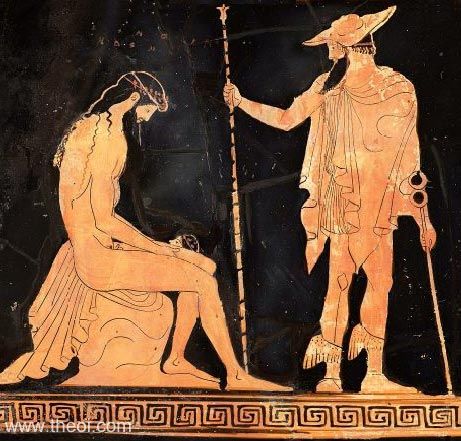
Euripides, Bacchae 1 ff (trans. Buckley) (Greek tragedy C5th B.C.) :
"Dionysos: I, the son of Zeus, have come to this land of the Thebans--Dionysos, whom once Semele, Kadmos' daughter, bore, delivered by a lightning-bearing flame . . . I see the tomb of my thunder-stricken mother here near the palace, and the remnants of her house, smouldering with the still living flame of Zeus' fire, the everlasting insult of Hera against my mother. I praise Kadmos, who has made this place hallowed, the shrine of his daughter; and I have covered it all around with the cluster-bearing leaf of the vine."
Euripides, Bacchae 90 ff :
"In the compulsion of birth pains, the thunder of Zeus flying upon her, his [Dionysos'] mother [Semele] cast from her womb, leaving life by the stroke of a thunderbolt. Immediately Zeus Kronides received him in a chamber fit for birth, and having covered him in his thigh shut him up with golden clasps, hidden from Hera. And he brought forth, when the Moirai (Fates) had perfected him, the bull-horned god (theos taurokeros), and he crowned him with crowns of snakes (drakones), for which reason Mainades cloak their wild prey over their locks."
Euripides, Bacchae 245 ff :
"Dionysos is a god . . . once stitched into the thigh of Zeus--Dionysos, his mother burnt up by the flame of lightning."
Euripides, Bacchae 285 ff :
"He [Dionysos] was sewn up in Zeus' thigh . . . when Zeus snatched him out of the lighting-flame, and led the child as a god to Olympos, Hera wished to banish him from the sky, but Zeus, as a god, had a counter-contrivance. Having broken a part of the air (aitheros) which surrounds the earth, he gave this [i.e. a phantom baby] to Hera as a pledge protecting the real Dionysos from her hostility. But in time, mortals say that he was nourished in the thigh of Zeus, changing the word [from homeros ‘hostage’ to meros ‘thigh’] because a god he had served as a hostage for the goddess Hera, and composing the story."
Euripides, Bacchae 520 ff :
"Daughter of Akheloios, venerable Dirke [spring on Mt Kithairon], happy virgin, you once received the child of Zeus [Dionysos] in your streams, when Zeus his father snatched him up from the immortal fire and saved him in his thigh, crying out : ‘Go, Dithyrambos, enter this my male womb. I will make you illustrious, Bakkhos, in Thebes, so that they will call you by this name.’"
Pseudo-Apollodorus, Bibliotheca 3. 26 - 29 (trans. Aldrich) (Greek mythographer C2nd A.D.) :
"Kadmos [and Harmonia] had as daughters Autonoe, Ino, Semele and Agaue . . . Zeus fell in love with Semele and slept with her, promising her anything she wanted, and keeping it all from Hera. But Semele was deceived by Hera into asking Zeus to come to her as he came to Hera during their courtship. So Zeus, unable to refuse, arrived in her bridal chamber in a chariot with lightning flashes and thunder, and sent a thunderbolt at her. Semele died of fright, and Zeus grabbed from the fire her six-month aborted baby, which he sewed into his thigh. After Semele's death the remaining daughters of Kadmos circulated the story that she had slept with a mortal, thereafter accusing Zeus, and because of this had been killed by a thunderbolt.
At the proper time Zeus loosened the stitches and gave birth to Dionysos, whom he entrusted to Hermes. Hermes took him to Ino and Athamas, and persuaded them to bring him up as a girl. Incensed, Hera inflicted madness on them, so that that Athamas stalked and slew his elder son Learkhos on the conviction that he was a dear, while Ino threw Melikertes into a basin of boiling water, and then, carrying both the basin and the corpse of the boy, she jumped to the bottom of the sea. Now she is called Leukothea, and her son is Palaimon: these names they receive from those who sail, for they help sailors beset by storms . . .
As for Zeus, he escaped Hera's anger by changing Dionysos into a baby goat. Hermes took him to the Nymphai of Asian Nysa, whom Zeus in later times places among the stars and named the Hyades."
Apollonius Rhodius, Argonautica 4. 1128 ff (trans. Rieu) (Greek epic C3rd B.C.) :
"Makris was the daughter of Aristaios, the honey-loving shepherd who discovered the secret of the bees and the riches that the olive yields in payment for our toil. It was Makris, who in Abantian Euboia, took the infant Dionysos to her bosom and moistened his parched lips with honey, when Hermes had rescued him from the flames and brought him to her. But Hera saw this and in her anger banished her from Euboia. So Makris came to the remote Phaiakian land, where she lived in the sacred cave and brought abundance to the people."
Diodorus Siculus, Library of History 4. 2. 3 (trans. Oldfather) (Greek historian C1st B.C.) :
"Zeus taking up the child [Dionysos from the body of its mother Semele], handed it over to Hermes, and ordered him to take it to the cave in Nysa, which lay between Phoinikia [Phoenicia] and Neilos [the River Nile], where he should deliver it to the Nymphai that they should rear it and with great solicitude bestow upon it the best of care. Consequently, since Dionysos was reared in Nysa, he received the name he bears from Zeus (Dios) and Nysa. And Homer bears witness to this in his Hymns, whence he says : ‘There is a certain Nysa, mountain high, with forests thick, in Phoinike afar, close to Aigyptos' streams.’ After he had received his rearing by the Nymphai in Nysa, they say, he made the discovery of wine and taught mankind how to cultivate the vine."
Pausanias, Description of Greece 3. 18. 11 (trans. Jones) (Greek travelogue C2nd A.D.) :
"[Amongst the scenes depicted on the throne of Apollon at Amyklai near Sparta :] Hermes is bearing the infant Dionysos to heaven."
Pausanias, Description of Greece 3. 24. 3 - 4 :
"The inhabitants [of Brasiae in Lakedaimonia] have a story, found nowhere else in Greece, that Semele, after giving birth to her son by Zeus, was discovered by Kadmos and put with Dionysos into a chest, which was washed up by the waves in their country. Semele, who was no longer alive when found, received a splendid funeral, but they brought up Dionysos. For this reason the name of their city, hitherto called Oreiatae, was changed to Brasiae after the washing up of the chest to land; so too in our time the common word used of the waves casting things ashore is ekbrazein. The people of Brasiae add that Ino in the course of her wanderings came to the country, and agreed to become the nurse of Dionysos. They show the cave where Ino nursed him, and call the plain the garden of Dionysos."
Plutarch, Life of Lysander 28. 4 (trans. Perrin) (Greek historian C1st to C2nd A.D.) :
"The spring called Kissousa (of the ivy) [on Mt Kithairon]. Here, as the story goes, his nurses [the Nysiades] bathed the infant Dionysos after his birth for the water has the color and sparkle of wine, is clear, and very pleasant to the taste."
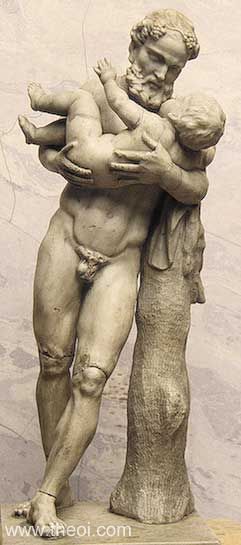
Philostratus the Elder, Imagines 1. 14 (trans. Fairbanks) (Greek rhetorician C3rd A.D.) :
"[Ostensibly a description of an ancient Greek painting in Neapolis (Naples) :] Bronte (Thunder), stern of face, and Astrape (Lightning) flashing light from her eyes, and raging fire from heaven that has laid hold of a king's house, suggest the following tale, if it is one you know. A cloud of fire encompassing Thebes breaks into the dwelling of Kadmos as Zeus comes wooing Semele; and Semele apparently is destroyed, but Dionysos is born, by Zeus, so I believe, in the presence of the fire. And the form of Semele is dimly seen as she goes to the heavens, where the Mousai (Muses) will hymn her praises : but Dionysos leaps forth as his mother's womb is rent apart and he makes the flame look dim, so brilliantly does he shine like a radiant star.
The flame, dividing, dimly outlines a cave for Dionysos more charming than any in Assyria and Lydia; for sprays of ivy grow luxuriantly about it and clusters of ivy berries and now grape-vines and stalks of thyrsos which spring up from the willing earth, so that some grow in the very fire. We must not be surprised if in honour of Dionysos the Fire (pyros) is crowned by the Earth (gê), for the Earth will take part with the Fire in the Bakkhic revel and will make it possible for the revelers to take wine from springs and to draw milk from clods of earth or from a rock as from living breasts. Listen to Pan, how he seems to be hymning Dionysos on the crests of Kithairon, as he dances an Euian fling. And Kithairon in the form of a man laments the woes soon to occur on his slopes, and he wears an ivy crown aslant on his head--for he accepts the crown most unwillingly--and [the Erinys] Megaira causes a fir to shoot up beside him and brings to light a spring of water, in token, I fancy, of the blood of Aktaion and of Pentheus."
Oppian, Cynegetica 4. 230 ff (trans. Mair) (Greek poet C3rd A.D.) :
"Ino, scion of Agenor, reared the infant Bakkhos and first gave her breast to the son of Zeus, and Autonoe likewise and Agaue joined in nursing him, but not in the baleful halls of Athamas, but on the mountain which at that time men called by the name Meros (Thigh). For greatly fearing the mighty spouse of Zeus [Hera] and dreading the tyrant Pentheus, son of Ekhion, they laid the holy child in a coffer of pine and covered it with fawn-skins and wreathed it with clusters of the vine, in a grotto where round the child they danced the mystic dance and beat drums and clashed cymbals in their hands, to veil the cries of the infant. It was around that hidden ark that they first showed forth their mysteries, and with them the Aionian women secretly took part in the rites. And they arrayed a gathering of their faithful companion to journey from that mountain out of the Boiotian land. For now, now was it fated that a land, which before was wild, should cutivate the vine at the instance of Dionysos who delivers from sorry. Then the holy choir took up the secret coffer and wreathed it and set it on the back of an ass. And they came unto the shores of Euripos, where they found a seafaring old man with his sons, and all together they besought the fishermen that they might cross the water in their boats. Then the old man had compassion on them and received on board the holy women. And lo! On the benches of his boat flowered the lush bindweed and flooming vine and ivy wreathed the stern. Now would the fishermen, cowering in god-sent terror, have dived into the sea, but ere that the boat came to land. And to Euboia the women came, carrying the god, and to the abode of Aristaios, who dwelt in a cave on the top of a mountain at Karyai and who instructed the life of country-dwelling men in countless things; he was the first to establish the flock of sheep; he first pressed the fruit of the oily wild olive, first curdled the milk with rennet [making cheese], and brought the gentle bees from the oak and shut them up in hives. He at that time received the infant Dionysos from the coffer of Ino and reared him in his cave and nursed him with the help of the Dryades and the Nymphai that have bees in their keeping and the maidens of Euboia and the Aionian women. And, when Dionysos was now come to boyhood, he played with the other children; he would cut a fennel stalk and smite the hard rocks, and from their wounds they poured for the god sweet liquor. Otherwhiles he rent rams, skins and all, and clove them piecemeal and cast the dead bodies on the ground; and again with his hands he neatly put their limbs together, and immediately they were alive and browsed on the green pasture. And now he was attended by holy companies, and over all the earth were spread the gifts of Dionysos, son of Thyone, and everywhere he went about showing forth his excellence to men."
Pseudo-Hyginus, Fabulae 155 (trans. Grant) (Roman mythographer C2nd A.D.) :
"Sons of Jove [Zeus] . . . Liber [Dionysos] by Semele, daughter of Cadmus and Harmonia."
Pseudo-Hyginus, Fabulae 167 :
"Liber [the Orphic Dionysos], son of Jove [Zeus] and Proserpine [Persephone], was dismembered by the Titanes, and Jove [Zeus] gave his heart, torn to bits, to Semele in a drink. When she was made pregnant by this, Juno [Hera], changing herself to look like Semele's nurse, Beroe, said to her : ‘Daughter, ask Jove [Zeus] to come to you as he comes to Juno [Hera], so you may know what pleasure it is to sleep with a god.’ At her suggestion Semele made this request of Jove [Zeus], and was smitten by a thunderbolt. He took Liber [Dionysos] from her womb, and gave him to Nysus to be cared for. For this reason he is called Dionysus, and also ‘the one with two mothers.’"
Pseudo-Hyginus, Fabulae 179 :
"Jove [Zeus] desired to lie with Semele, and when Juno [Hera] found out, she changed her form to that of the nurse Beroe, came to Semele, and suggested that she ask Jove to come to her as he came to Juno [Hera], ‘that you may know,’ she said, ‘what pleasure it is to lie with a god.’ And so Semele asked Jove [Zeus] to come to her in this way. Her request was granted, and Jove [Zeus], coming with lightning and thunder, burned Semele to death. From her womb Liber [Dionysos] was born. Mercurius [Hermes] snatched him from the fire and gave him to Nysus [Seilenos] to be reared. In Greek he is called Dionysus."
Pseudo-Hyginus, Fabulae 182 :
"The Nymphae which are called Dodonides (others call them Naides) [text mising] Their names are Cisseis, Nysa, Erato, Eriphia, Bromie, Polyhymno. On Mount Nysa these obtained a boon from their foster-son [Dionysos], who made petition to Medea. Putting off old age, they were changed to young girls, and later, consecrated among the stars, they are called Hyades (rainy ones). Others report that they were called Arsinoe, Ambrosie, Bromie, Cisseis, and Coronis."
Pseudo-Hyginus, Fabulae 192 :
"Atlas by Pleione or an Oceanid had twelve daughters, and a son Hyas . . . The five of them first put among the stars have their place between the horns of the bull--Phaesyla, Ambrosia, Coronis, Eudora, Polyxo--and are called from their brother's name, Hyades . . . There are those who think they are among the stars because they were the nurses of Father Liber [Dionysos] whom Lycurgus drove out from the island of Naxos."
Pseudo-Hyginus, Astronomica 2. 21 :
"The stars which outline the face [of the constellation Taurus] are called Hyades. These, Pherecydes the Athenian [mythographer C5th B.C.] says, are the nurses of Liber [Dionysos], seven in number, who earlier were nymphae called Dodonidae. Their names are as follows: Ambrosia, Eudora, Pedile, Coronis, Polyxo, Phyto, and Thyone. They are said to have been put to flight by Lycurgus and all except Ambrosia took refuge with Thetis, as Asclepiades says. But according to Pherecydes, they brought Liber [Dionysos] to Thebes and delivered him to Ino, and for this reason Jove [Zeus] expressed his thanks to them by putting them among the constellations."
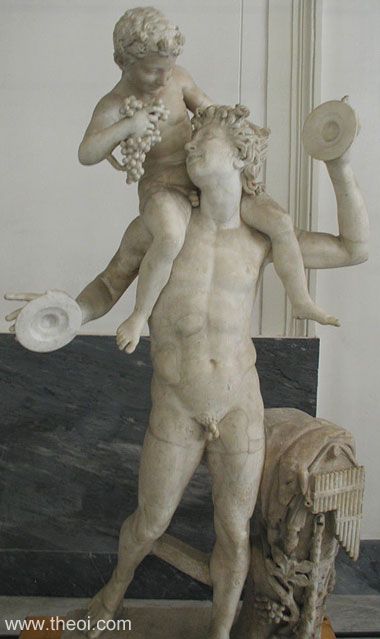
Ovid, Metamorphoses 3. 304 ff (trans. Melville) (Roman epic C1st B.C. to C1st A.D.) :
"The girl [Semele], unwittingly, asked of Jove [Zeus] a boon unnamed . . . [and she] doomed by her lover's generosity, answered ‘Give me yourself in the same grace as when your Saturnia [Hera] holds you to her breast in love's embrace.’ . . . As far as he [Zeus] had power, to curb his might, and would not wield the fire with which he's felled hundred-handed Typhoeus. That was too fierce. There is another bolt, a lighter one, in which the Cyclopes forged a flame less savage and a lesser wrath, called by the gods his second armament. With this in hand he went to Semele in Cadmus' palace. Then her mortal frame could not endure the tumult of the heavens; that gift of love consumed her. From her womb her baby, still not fully formed, was snatched, and sewn (could one believe the tale) inside his father's thigh, and so completed there his mother's time. Ino, his mother's sister, in secret from the cradle nursed the child and brought him up, and then the Nymphae Nyseides were given his charge and kept him hidden away within their caves, and nourished him on milk. Down on earth as destiny ordained these things took place, and Bacchus [Dionysos], baby twice born, was cradled safe and sound."
Ovid, Fasti 3. 767 ff (trans.Boyle) (Roman poetry C1st B.C. to C1st A.D.) :
"Bacchus [Dionysos] loves the ivy most. Why this, too, is so, takes no time to learn. They say that, when his stepmother [Hera] hunted for the boy, Nymphae from Nysa screened the crib with its leaves."
Pliny the Elder, Natural History 6. 78 (trans. Rackham) (Roman encyclopedia C1st A.D.) :
"Most people assign to India the city of Nisa and Mount Merus which his sacred to father Liber [Dionysos], this being the place from which originated the myth of the birth of Liber [Dionysos] from the thigh of Jove [Zeus]."
Seneca, Hercules Furens 455 ff (trans. Miller) (Roman tragedy C1st A.D.) :
"Knowest thou not what heavy ills he bore in infancy? Ripped by a thunderbolt from his mother's womb, a boy [Dionysos] in after-time stood next his sire, the Thunderer [Zeus]."
Seneca, Oedipus 418 ff :
"When, fearing thy stepdame's [Hera's] wrath, thou [Dionysos] didst grow to manhood with false-seeming limbs, a pretended maiden with golden ringlets, with saffron girdle binding thy garments."
Seneca, Oedipus 444 ff :
"Cadmean Ino, foster-mother of shining Bacchus."
The birth of Dionysos is descibed in some detail in Nonnus' Dionysiaca. Only a few selected paragraphs are currently quoted here:--
Nonnus, Dionysiaca 9. 28 ff (trans. Rouse) (Greek epic C5th A.D.) :
"[Hermes] gave him [the new born babe Dionysos just delivered from Zeus' thigh] to the [Lamides] daughters of Lamos, river Nymphai--the son of Zeus, the vineplanter. They received Bakkhos into their arms; and each of them dropt the milky juice of her breast without pressing into his mouth. And the boy lay on his back unsleeping, and fixt his eye on the heaven above, or kicked at the air with his two feet one after the other in delight, and laughed in wonder to see his father's vault of stars.
The consort of Zeus beheld the babe, and suffered torments. Through the wrath of resentful Hera, the daughters of Lamos were maddened by the lash of that divine mischiefmaker. In the house they attacked the servants, in threeways they carved up the wayfaring man with alienslaying knife; they howled horrible, with violent convulsions they rolled the eyes in their disfigured faces; they scampered about this way and that way at the mercy of their wandering wits, running and skipping with restless feet, and the mad breezes made their wandering locks dance wildly into the air; the yellow shift round the bosom of each was whitened with drops of foam from the lips of the girls. Indeed they would have chopt up little Bakkhos [Dionysos] a baby still piecemeal in the distracted flood of their vagabond madness, had not Hermes come on wing and stolen Bakkhos again with a robber's untracked footsteps."
Nonnus, Dionysiaca 14. 143 ff :
"Another kind of the twiform Kentauroi (Centaurs) . . . were the sons of the water Neiades in mortal body, whom men call Hyades, offspring of the river Lamos. They [the sons] had played the nurses for the babe that Zeus had so happily brought forth, Bakkhos, while he still had a breath of the sewn-up birth-pocket. They were the cherishing saviours of Dionysos when he was hidden from every eye, and then they had nothing strange in their shape; in that dark cellar they often dandled the child in bended arms, still a child at play, but a clever babe. Or he would mimic a newborn kid; hiding in the fold, he covered his body with long hair, and in this strange shape let out a deceptive bleat between his teeth, and pretended to walk on hooves in goatlike steps. Or he would show himself like a young girl in saffron robes and take on the feigned shape of a woman; to mislead the mind of spiteful Hera, he moulded his lips to speak in a girlish voice, tied a scented veil on his hair. He put on all a woman's manycoloured garments: fastened a maiden's vest about his chest and the firm circle of his bosom, and fitted a purple girdle over his hips like a band of maidenhood.
But his guile was useless. Hera, who turns her all-seeing eye to every place, saw from on high the everchanging shape of Lyaios [Dionysos], and knew all. Then she was angry with the guardians of Bromios. She procured from Thessalian Akhlys (Misery) treacherous flowers of the field, and shed a sleep of enchantment over their heads; she distilled poisoned drugs over their hair, she smeared a subtle magical ointment over their faces ,and changed their earlier human shape. Then they took the form of a creature with long ears, and a horse's tail sticking out straight from the loins and flogging the flanks of its shaggy-crested owner; from the temples cow's horns sprouted out, their eyes widened under the horned forehead, the hair ran across their heads in tuft, long white teeth grew out of their jaws, a strange kind of mane grew of itself, covering their necks with rough hair, and ran down from the loins to feet underneath."
See also Dionysus Mentored by Rhea-Cybele (sometimes his nurse)
For MORE information on the various nurses of Dionysos see:
NYSIADES, HYADES, NAXIAN NYMPHAI, LAMIDES, INO-LEUKOTHEA, MAKRIS, MYSTIS, RHEA-KYBELE
For MORE information on the various protectors and mentors of Dionysos see:
SEILENOS, ARISTAIOS, PHERES LAMIOI, KOURETES
MOUNT NYSA BIRTHPLACE OF DIONYSUS
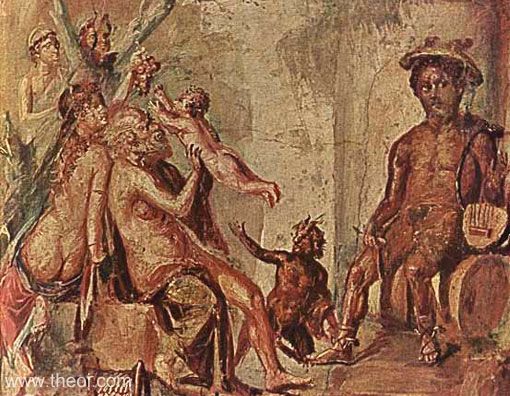
Mt Nysa was originally identified with Mt Kithairon in Boiotia, the seat of the Dionysian orgies on the Greek mainland. Later writers identified it with various holy mountains sacred to eastern vegetation gods, from Phoenicia to Thrake, Egypt, Arabia and even distant India. Hesychius (C5th A.D. Byzantine lexicon) gives a list of the following locations proposed by ancient authors as the site of Mt Nysa: Arabia, Ethiopia, Egypt, Babylon, Erythraian Sea [the Red Sea], Thrake, Thessaly, Kilikia, India, Libya, Lydia, Makedonia, Naxos, around Pangaios [mythical island south of Arabia], Syria. The ancients thought the god was named for the mountain, but it is possible that the reverse was true.
I. MT NYSA, UNSPECIFIED LOCATION
Homer, Iliad 6. 129 ff (trans. Lattimore) (Greek epic C8th B.C.) :
"Lykourgos the powerful . . . once drove the nurses of rapturous (mainomenos) Dionysos headlong down the sacred Nyseian hill."
Homeric Hymn 26 to Dionysus (trans. Evelyn-White) (Greek epic C7th to 4th B.C.) :
"The rich-haired Nymphai received him [Dionysos] in their bosoms from the lord his father and fostered and nurtured him carefully in the dells of Nysa, where by the will of his father he grew up in a sweet-smelling cave."
Ovid, Metamorphoses 3. 304 ff (trans. Melville) (Roman epic C1st B.C. to C1st A.D.) :
"The Nymphae Nyseides were given his [Dionysos'] charge and kept him hidden away within their caves."
Suidas s.v. Nyseion (trans. Suda On Line) (Byzantine Greek lexicon C10th A.D.) :
"Nysêïon: [Pertaining to] a mountain of Dionysos."
II. MT NYSA IN BOEOTIA (CENTRAL GREECE)
The Mountain was usually, or originally, identified with Mt Kithairon in Boiotia. The Eleusinian plain below it was also called the Nyseian in the story of Persephone (cf. Homeric Hymn to Demeter).
Plutarch, Life of Lysander 28. 4 (trans. Perrin) (Greek historian C1st to C2nd A.D.) :
"The spring called Kissousa (of the ivy) [on Mt Kithairon]. Here, as the story goes, his nurses [the Nysiades] bathed the infant Dionysos after his birth."
Philostratus the Elder, Imagines 1. 14 (trans. Fairbanks) (Greek rhetorician C3rd A.D.) :
"[From a description of an ancient Greek painting:]
The flame, dividing, dimly outlines a cave for Dionysos more charming than any in Assyria and Lydia; for sprays of ivy grow luxuriantly about it and clusters of ivy berries and now grape-vines and stalks of thyrsos which spring up from the willing earth, so that some grow in the very fire . . . And Kithairon in the form of a man laments the woes soon to occur on his slopes, and he wears an ivy crown aslant on his head."
Oppian, Cynegetica 4. 230 ff (trans. Mair) (Greek poet C3rd A.D.) :
"Ino, scion of Agenor, reared the infant Bakkhos and first gave her breast to the son of Zeus, and Autonoe likewise and Agaue joined in nursing him . . . on the mountain [in Boiotia] which at that time men called by the name Meros (Thigh)."
Pseudo-Hyginus, Fabulae 131 (trans. Grant) (Roman mythographer C2nd A.D.) :
"When Liber [Dionysos] was leading his army into India, he gave the authority over his Theban kingdom to his nurse Nysus [and later reclaiming the mountain introduced his orgies there]."
III. MT NYSA IN NAXOS (GREEK AEGEAN)
Homeric Hymn 1 to Dionysus (trans. Evelyn-White) (Greek epic C7th to 4th B.C.) :
"For some say, at Drakanon on windy Ikaros; and some, in Naxos, O [Dionysos] . . . that pregnant Semele bare you to Zeus the thunder-lover."
Pseudo-Hyginus, Fabulae 192 (trans. Grant) (Roman mythographer C2nd A.D.) :
"The nurses of Father Liber [Dionysos] whom Lycurgus drove out from the island of Naxos."
IV. MT NYSA IN PHOENICIA (WEST ASIA)
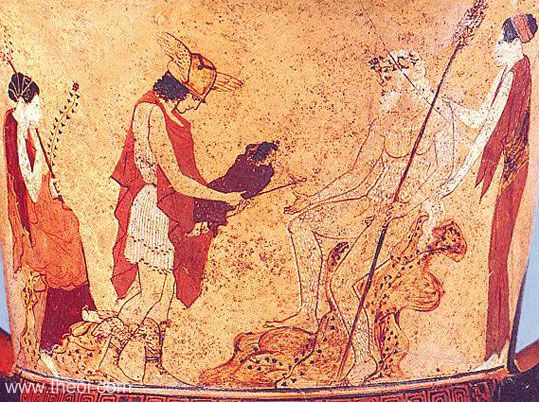
Homeric Hymn 1 to Dionysus (trans. Evelyn-White) (Greek epic C7th to 4th B.C.) :
"[Zeus] gave you [Dionysos] birth remote from men and secretly from white-armed Hera. There is a certain Nysa, a mountain most high and richly grown with woods, far off in Phoinike, near the streams of Aigyptos."
Pseudo-Apollodorus, Bibliotheca 3. 29 (trans. Aldrich) (Greek mythographer C2nd A.D.) :
"Hermes took him [the infant Dionysos] to the Nymphai of Asian Nysa."
Diodorus Siculus, Library of History 4. 2. 3 (trans. Oldfather) (Greek historian C1st B.C.) :
"Zeus taking up the child [Dionysos from the body of its mother Semele], handed it over to Hermes, and ordered him to take it to the cave in Nysa, which lay between Phoinikia and the Neilos [River Nile in Egypt], where he should deliver it to the Nymphai that they should rear it . . . And Homer bears witness to this in his Hymns, whence he says : ‘There is a certain Nysa, mountain high, with forests thick, in Phoinike afar, close to Aigyptos' streams.’"
Pliny the Elder, Natural History 5. 74 (trans. Rackham) (Roman encyclopedia C1st A.D.) :
"[Near Damascus in Syria is] Scythopolis, formerly Nysa, after Father Liber's [Dionysos'] nurse, whom he buried there."
V. MT NYSA IN ARABIA (WEST ASIA)
Herodotus, Histories 3. 111 (trans. Godley) (Greek historian C5th B.C.) :
"As for cinnamon . . . where it comes from and what land produces it they cannot say, except that it is reported, reasonably enough, to grow in the places where Dionysos was reared [i.e. Mount Nysa] . . . cinnamon is said to be gathered, and to come from Arabia to other lands." [N.B. Cinnamon was a popular ancient Greek additive to wine.]
VI. MT NYSA IN EGYPT (NORTH AFRICA)
Herodotus, Histories 3. 97 :
"The Aithiopians nearest to Egypt . . . those who dwell about the holy Nysa, where Dionysos [Osiris] is the god of their festivals." [N.B. Mount Barkal in Upper Nubia, identified by Herodotus with the legendary Mount Nysa.]
VII. MT NYSA IN INDIA (SOUTH ASIA)
Philostratus, Life of Apollonius of Tyana 2. 2 (trans. Conybeare) (Greek biography C1st to 2nd A.D.) :
"They say that a leopard was once caught in Pamphylia which was wearing a chain round its neck, and the chain was of gold, and on it was inscribed Armenian lettering : ‘the King Arsakes to the Nysian God (theos Nysios).’ Now the king of Armenia was certainly at that time Arsakes, and he, I imagine, finding the leopard, had let it go free in honour of Dionysos because of its size. For Dionysos is called Nysios (Nysian) by the Indians and by all the Oriental races from Nysa in India."
Philostratus, Life of Apollonius of Tyana 2. 6 - 10 :
"They [the legendary prophet Apollonios of Tyana of the C1st A.D. and his companions] were now in land subject to the king [of India], in which the mountain of Nysa rises covered to its very top with plantations, like the mountain of Tmolos in Lydia; and you can ascend it, because paths have been made by the cultivators."
Philostratus, Life of Apollonius of Tyana 2. 6 - 10 :
"[The Indians] who inhabit the district between the Indos and the Hydroates [Hydapses] and the continental region beyond which ends at the river Ganges, declare that Dionysos [perhaps a local Indian wine-god identified with the Greek god] was son of the River Indos, and that the Dionysos of Thebes having become his disciple took to the thyrsos and introduced it in the orgies; that this Dionysos declared that he was the son of Zeus and had lived safe inside his father's thigh until he was born, and that he found a mountain called Meros or ‘Thigh’ on which Nysa borders, and planted Nysa in honour of Dionysos with the vine of which he had brought the suckers from Thebes."
Pliny the Elder, Natural History 6. 78 (trans. Rackham) (Roman encyclopedia C1st A.D.) :
"Most people assign to India the city of Nisa and Mount Merus which his sacred to father Liber [Dionysos], this being the place from which originated the myth of the birth of Liber [Dionysos] from the thigh of Jove [Zeus]."
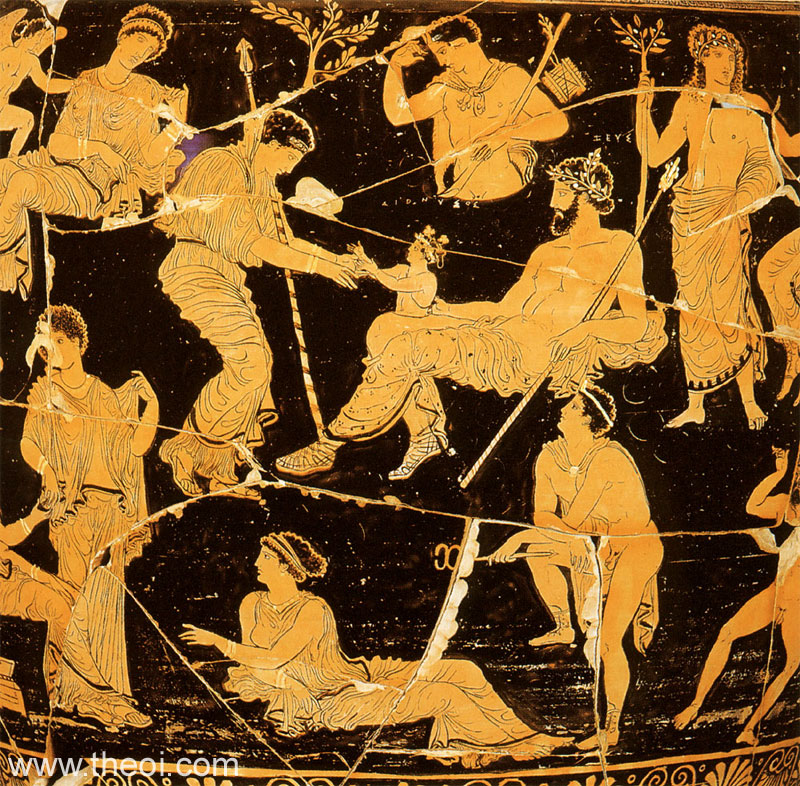
SOURCES
GREEK
- Homer, The Iliad - Greek Epic C8th B.C.
- Hesiod, Theogony - Greek Epic C8th - 7th B.C.
- The Homeric Hymns - Greek Epic C8th - 4th B.C.
- Greek Lyric I Terpander, Fragments - Greek Lyric C7th B.C.
- Euripides, Bacchae - Greek Tragedy C5th B.C.
- Herodotus, Histories - Greek History C5th B.C.
- Apollodorus, The Library - Greek Mythography C2nd A.D.
- Apollonius Rhodius, The Argonautica - Greek Epic C3rd B.C.
- Diodorus Siculus, The Library of History - Greek History C1st B.C.
- Pausanias, Description of Greece - Greek Travelogue C2nd A.D.
- Plutarch, Lives - Greek Historian C1st - 2nd A.D.
- The Orphic Hymns - Greek Hymns C3rd B.C. - C2nd A.D.
- Philostratus the Elder, Imagines - Greek Rhetoric C3rd A.D.
- Philostratus, Life of Apollonius of Tyana - Greek Biography C2nd A.D.
- Oppian, Cynegetica - Greek Poetry C3rd A.D.
- Nonnus, Dionysiaca - Greek Epic C5th A.D.
ROMAN
- Hyginus, Fabulae - Latin Mythography C2nd A.D.
- Hyginus, Astronomica - Latin Mythography C2nd A.D.
- Ovid, Metamorphoses - Latin Epic C1st B.C. - C1st A.D.
- Ovid, Fasti - Latin Poetry C1st B.C. - C1st A.D.
- Pliny the Elder, Natural History - Latin Encyclopedia C1st A.D.
- Seneca, Hercules Furens - Latin Tragedy C1st A.D.
- Seneca, Oedipus - Latin Tragedy C1st A.D.
BIBLIOGRAPHY
A complete bibliography of the translations quoted on this page.